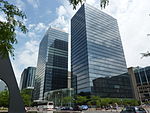Statistics Belgium
Statistics Belgium (formerly known as the NSI) is part of the Federal Public Service Economy, SMEs, Self-Employed and Energy. Statistics Belgium conducts surveys among households and enterprises in Belgium. It uses and processes existing administrative databases (the national register) and provides data to Belgian and international authorities and organisations. Third parties may also call on its statistical expertise. Statistics Belgium is also the official representative of Belgium to international organisations such as Eurostat and OECD. Sets of figures, press releases and studies are published on its website, Statbel. Moreover, a number of databases can be queried through the online application be.STAT.
Excerpt from the Wikipedia article Statistics Belgium (License: CC BY-SA 3.0, Authors).Statistics Belgium
Boulevard du Roi Albert II - Koning Albert II-laan, City of Brussels
Geographical coordinates (GPS) Address Nearby Places Show on map
Geographical coordinates (GPS)
| Latitude | Longitude |
|---|---|
| N 50.858225 ° | E 4.3556694444444 ° |
Address
North Gate Ⅱ
Boulevard du Roi Albert II - Koning Albert II-laan 8
1000 City of Brussels (Brussels)
Belgium
Open on Google Maps










